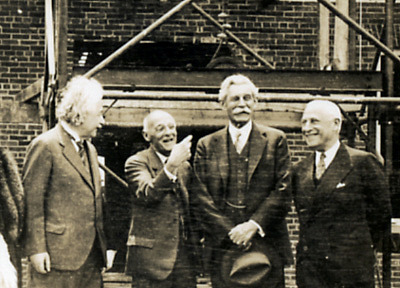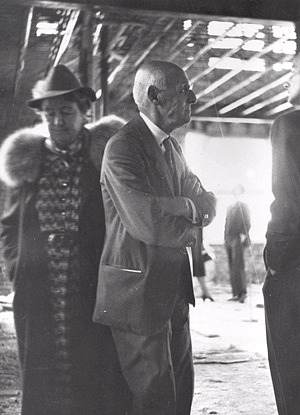Abraham Flexner: Legacy
More than any other individual, it was Abraham Flexner who conceived and developed the idea that found expression as the Institute for Advanced Study. Flexner had a profound impact on many areas of American education, especially medical education. His influence can be seen even today in the training of medical professionals, the culture of the physician, and the relationship between medical research and practice. But the Institute remains at the heart of his legacy.

In this field it seemed to me that the time was ripe for the creation in America of an institute in the field of general scholarship and science…not a graduate school, training men in the known and to some extent in methods of research, but an institute where everyone—faculty and members—took for granted what was known and published, and in their individual ways, endeavored to advance the frontiers of knowledge.
Following his careful analysis of such institutions as Oxford’s All Souls College, the Collège de France, and the late-nineteenth-century German universities, Flexner recognized the need for an advanced research institution in the United States.
In late 1929, when Flexner was expanding some of his lectures into a book, Universities: American, English, German, he was approached by two visitors for advice concerning the philanthropic use of a large sum of money. Later, he recorded the event in Abraham Flexner: An Autobiography. “I was working quietly one day when the telephone rang and I was asked to see two gentlemen who wished to discuss with me the possible uses to which a considerable sum of money might be placed. At our interview, I informed them that my competency was limited to the education field and that in this field it seemed to me that the time was ripe for the creation in America of an institute in the field of general scholarship and science, resembling the Rockefeller Institute in the field of medicine—developed by my brother Simon—not a graduate school, training men in the known and to some extent in methods of research, but an institute where everyone—faculty and members—took for granted what was known and published, and in their individual ways, endeavored to advance the frontiers of knowledge.”
The two gentlemen were Samuel Leidesdorf and Herbert Maass, representatives of two elderly clients from Newark, New Jersey: Louis Bamberger and his sister Caroline Bamberger Fuld, the recent widow of Louis’s partner and friend Felix Fuld. With the death of Felix Fuld in January 1929, Louis Bamberger had become the sole head of one of the country’s leading department stores, the Newark-based L. Bamberger & Co., a business that had begun almost forty years earlier. Louis Bamberger and Caroline Fuld sold the store to R. H. Macy and Company of New York for some $25 million just weeks before the stock-market crash in October 1929.

The Fulds and Louis Bamberger were deeply committed to community service. They contributed to charities, particularly those serving the Jewish community, including hospitals, youth clubs, museums, the Jewish Theological Seminary, and Newark’s Beth Israel Hospital. In 1923, Louis Bamberger donated $650,000 to construct a building for the Newark Museum. Immediately after the sale of L. Bamberger & Co., Bamberger and Fuld began searching for a use for their considerable fortune. Feeling that they had benefited greatly from the State of New Jersey, and from the people of Newark in particular, Bamberger and Fuld thought of establishing a medical school either in Newark or on the Fuld estate in South Orange. They hoped to do something to counter the prejudice against Jews they perceived as prevalent in the medical profession and in medical education. They therefore proposed to establish a medical school in Newark that would give preference to Jewish students.
To find out whether their project was feasible, in 1929 they enlisted the help of their friend of many years Samuel Leidesdorf, an accountant and their business adviser, who in turn solicited the help of his friend Herbert Maass, a senior partner in the New York law firm of Maass and Davidson, the firm that had acted for Macy’s when it acquired L. Bamberger & Co. From their inquiries, Leidesdorf and Maass were led to the most influential figure in the field of medical education, Abraham Flexner.

Have you ever dreamed a dream?
Maass and Leidesdorf had found the right man, but his advice was not what was expected. Flexner argued that a first-rate medical school required an outstanding teaching hospital and that it needed to be associated with a leading university, neither of which existed in Newark; nor did he think that the way to counter anti-Semitism would be to set up institutions favoring Jews. Instead he asked his visitors, “Have you ever dreamed a dream?” and proceeded to tell them his: the establishment in America of a purely graduate university, devoted to learning and researching rather than undergraduate teaching.
Maass and Leidesdorf (both of whom would later play significant roles on the Board of the Institute) returned to their clients with a copy of a memorandum conveying Flexner’s conception of a modern university as a true society of scholars. Such was Flexner’s charisma and reputation that Louis Bamberger and Caroline Fuld were quickly captivated by his vision. From the initial meeting in the fall of 1929, it was a matter of months until the formal establishment of the Institute, with Flexner at its helm, in June of 1930.
The Institute exists today largely due to Flexner’s vision and enthusiasm. His dream has proved successful. He was prescient in seeing the need for an institution that crosses disciplinary boundaries and is not constrained by an undergraduate curriculum; that provides scholars and scientists of proven achievement the opportunity to pursue research driven by their own intellectual curiosity; that selects only on the basis of ability, attracting the ablest researchers from around the world; whose structure is flexible (“plastic”) so that it can change with time; that remains relatively small so that it retains a sense of community; a true academic village—a community of scholars.